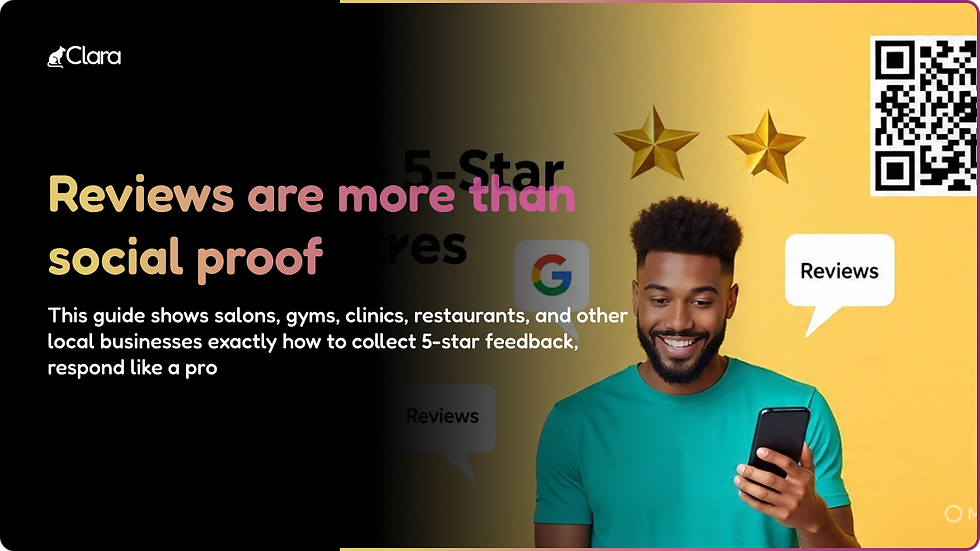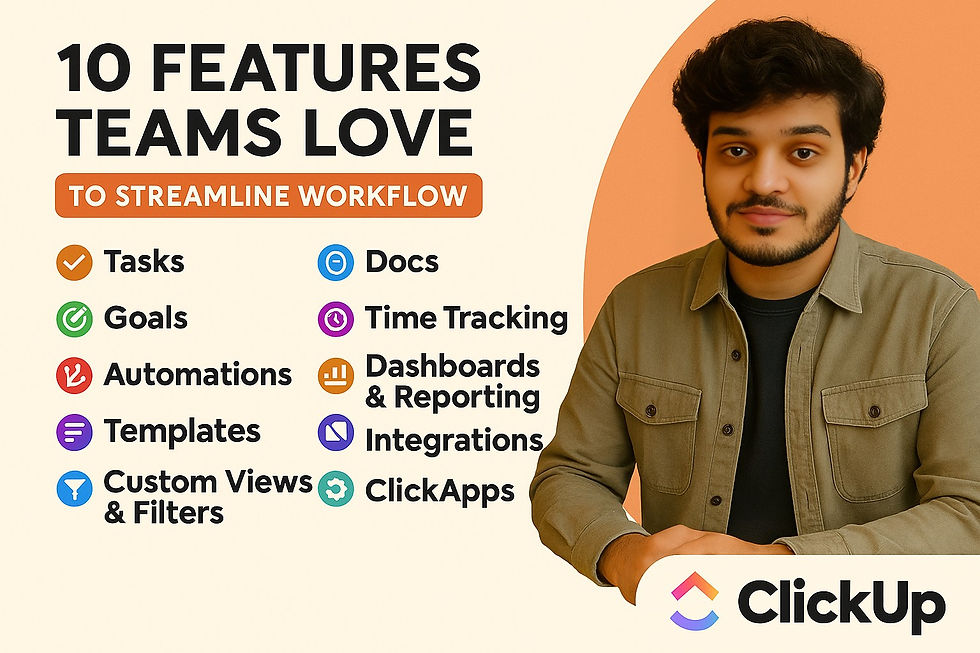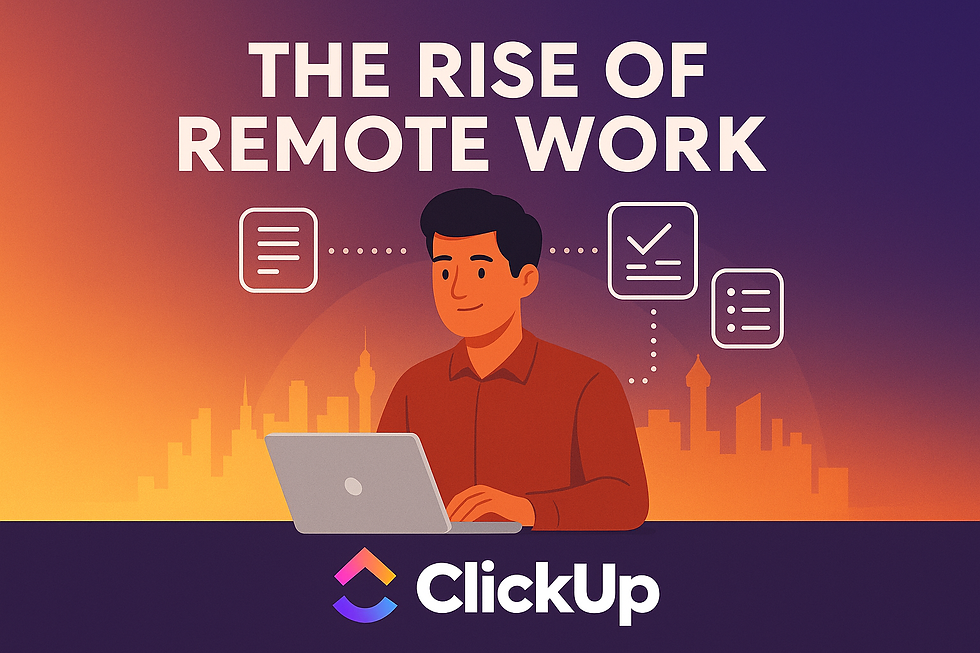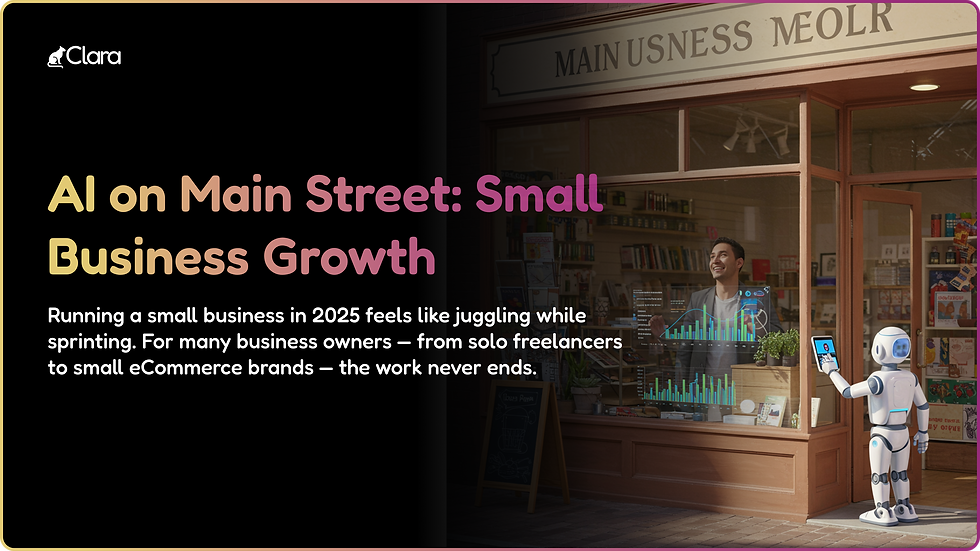- Dravya Bansal
- Nov 13, 2023
- 11 min read
As a restaurant owner, you can have the best ambiance, excellent menu, ample waitstaff coverage and still lose customers to your competitors.
Then again, you can have naive interns asking people if they’d like dessert after the main course and make a mint.
The outcome depends on the quality of your restaurant’s customer service.
According to a Deloitte report, 60 percent of customers will frequently visit restaurants where they had a positive experience.
So a great way to drive repeat business and increase restaurant sales is to keep the quality of your customer service high.
In this post, we’ll discuss the 11 elements of excellent restaurant customer service.
Key Takeaways
Exceptional customer service is the foundation of a successful restaurant.
Here are the key pillars of great customer service:
Personalized Experiences: Understand customer preferences and tailor recommendations accordingly.
Effective Communication: Promptly address concerns and maintain clear communication throughout their dining experience.
Empowered Employees: Invest in training to equip staff with skills to deliver exceptional service.
Strong Online Presence: Engage with customers online, respond to reviews, and promote special offers.
Welcoming Atmosphere: Cultivate a friendly and inviting environment that makes guests feel comfortable.
Consistent Service Standards: Implement standardized procedures and maintain consistent service levels across all touchpoints.
Customer Feedback: Actively gather feedback, analyze it to identify areas for improvement, and make data-driven decisions.
Implement these strategies and prioritize customer satisfaction to achieve exceptional results.
Why is restaurant customer service important?
In the restaurant business, providing excellent customer service is necessary since it affects the establishment’s overall success.
Exceptional customer service is vital for restaurant success as it:
Boosts customer satisfaction and loyalty, leading to increased profits and repeat business (5% retention = 25%-95% profit increase).
Promotes positive word-of-mouth and online reviews, attracting new customers (88% of customers trust online reviews as much as personal recommendations).
Mitigates negative feedback and reputational damage, protecting revenue (68% of customers won’t return after a negative experience).
Improve staff morale and productivity, fostering a positive work environment and boosting efficiency (High employee engagement = 21% higher profitability, 17% higher productivity).
Increases customer lifetime value, generating more revenue from existing customers (5% retention = 75% lifetime value increase).
Now, let’s take a look at the top 11 great customer service examples below.
11 Examples of great restaurant customer service
The following is a list of 11 examples of excellent customer service along with descriptions of each:
1. Present the proper staff etiquette
Explanation:
Train your staff about proper etiquette
Proper restaurant etiquette is essential for creating a positive customer dining experience.
When your staff is well-trained in etiquette, they can help to create a welcoming and enjoyable atmosphere for your guests.
Examples:
Here are examples of proper restaurant etiquette
Greeting customers politely: When customers arrive at your restaurant, they should be greeted with a warm smile and a friendly welcome. This sets the tone for their entire dining experience.
Speaking politely to customers: Your staff should always address customers with respect and courtesy. Avoid using slang or informal language, and always make sure to listen attentively to customers’ requests.
Being attentive to customers’ needs: Your staff should be aware of customers’ needs and respond promptly to their requests. They should also be proactive in offering assistance, such as refilling drinks or clearing plates.
Maintaining a clean and orderly appearance: Your staff should be well-dressed and well-groomed. They should also keep their work areas clean and tidy.
Being knowledgeable about the restaurant’s menu and wine list: Your staff should be able to answer customers’ questions about the menu and wine list. They should also be able to make recommendations based on customers’ preferences.
2. Go the extra mile
Explanation:
Delight your restaurant customers with exceptional service
Going the extra mile for your restaurant customers means going above and beyond what is expected to provide them with an exceptional dining experience.
“Here is a simple but powerful rule: always give people more than what they expect to get.” – Nelson Boswell, Author.
This will help to create loyal customers who will come back for more and spread the word about your restaurant to their friends and family.
Examples:
Here are examples of how to go the extra mile for your customers
Identify what your competitors are neglecting: Take some time to visit your local competitors and observe their customer service. What are they doing well? What could they improve on?
Offer something unexpected: Surprise your customers by offering them something they didn’t expect, such as a free bottle of water, a complimentary appetizer, or a special dessert.
Use creative signage: For example, a sign with a sentence saying “Wait to be seated” can be reworded to “Please give us a few minutes as our awesome staff prepares your table.”
Personalize the experience: Take the time to get to know your customers and their preferences. This will allow you to provide them with a more personalized experience, which they will appreciate.
Go above and beyond to resolve problems: If a customer has a problem, don’t just apologize and move on. Make sure that the problem is resolved to the customer’s satisfaction.
Take a look at a unique example of a restaurant going the extra mile to help attract customers:
By going the extra mile for your customers, you can create a loyal following and ensure that your restaurant is the one they choose time and time again
3. Give VIPs the treatment they deserve
Explanation:
Improve your customer service with guest data
As a restaurant owner, you strive to provide exceptional customer service that sets your establishment apart.
However, you might find yourself in a plateau, wondering how to elevate your service from good to great.
The answer lies in guest data, a treasure trove of insights that can transform your customer interactions.
Guest data is the key to unlocking personalized experiences that make VIPs feel valued and appreciated.
By harnessing the power of this data, you can gain a deep understanding of your customers’ preferences, allergies, dietary restrictions, and seating preferences.
This knowledge empowers your staff to anticipate needs and deliver an unmatched personalized experience.
Examples:
Utilize guest data for VIP treatments
Detailed guest profiles: Create comprehensive profiles for each guest, encompassing personal details, allergies, food and drink preferences, and seating arrangements. This information enables staff to understand guest needs even before they’re expressed.
PMS integration: Integrate your restaurant management software with your PMS (Property Management System) if you manage restaurants within a hotel. This integration provides access to valuable data such as room numbers, length of stay, check-in/check-out dates, and preferences, enabling tailored experiences.
Server notes and tags: Encourage servers to add special notes and tags to each guest profile. These notes can capture specific preferences, requests, or anecdotes to personalize the guest’s experience. Tags like “VIP” or “high-spender” alert staff to provide exceptional attention.
Feedback collection and analysis: Gather feedback through post-dining surveys, review platforms, and direct interactions. Analyze this feedback regularly to identify areas for improvement and celebrate areas of excellence.
CRM segmentation and targeting: Utilize CRM (Customer Relationship Management) systems or restaurant automation platforms to segment your customer base. Target specific groups with personalized messages, promotions, and offers, making them feel valued and appreciated.
Exclusive perks and privileges: Show your VIPs how much you appreciate their patronage by offering exclusive perks and privileges. Consider providing complimentary appetizers, special menu items, or priority reservations to make them feel like esteemed guests.
By implementing these strategies and leveraging guest data, you can transform your restaurant into a haven for exceptional service, fostering loyalty and driving long-term success.
4. Throw in a surprise or two
Explanation:
Surprise and delight your guests
Adding an element of surprise to your guests’ dining experience can go a long way in enhancing their satisfaction and fostering loyalty.
By offering unexpected treats or recognizing their preferences, you can create a memorable and enjoyable experience for them.
Examples:
Delightful surprises for your guests
Special dishes and deals: Inform guests about any special dishes for the day or ongoing discounts and deals. This demonstrates that your restaurant is dynamic and offers unique culinary experiences.
Plat du Jour: Offer a “plat du jour,” a special meal with a main course, beverage, and appetizer or dessert at a set price. This provides guests with a value-added option and encourages them to try new dishes.
Complimentary dish for repeat customers: If a repeat customer frequently orders the same dish, consider offering it on the house as a gesture of appreciation. This shows that you value their patronage and pay attention to their preferences.
Here’s a real life example of a restaurant that adds an element of surprise when you order one of their famous dishes.
It’s also a great opportunity to make a birthday celebration unforgettable:
By incorporating these surprising elements into your service, you can create a memorable dining experience that leaves a lasting impression on your guests.
5. Offer seasonal experiences
Explanation:
Embrace seasonal experiences
Adapting your menu and offerings to align with different seasons can significantly improve customer satisfaction and attract new patrons.
By showcasing seasonal ingredients and creating unique experiences, you can demonstrate your commitment to freshness and innovation.
Examples:
Improve customer experience with seasonal offerings
Seasonal Menu Specials: Introduce special dishes that highlight fresh, seasonal produce and flavors. This demonstrates your commitment to quality and keeps your menu exciting and engaging.
Al Fresco Dining: During the summer months, offer outdoor dining options to provide guests with a refreshing and enjoyable experience. This can also help alleviate long wait times and enhance customer satisfaction.
Fresh Produce: Prioritize the use of seasonal ingredients to create dishes that are bursting with flavor and reflect the vibrancy of the season. This showcases your dedication to culinary excellence and freshness.
By embracing seasonal experiences, you can create a dynamic and engaging dining environment that keeps your customers coming back for more.
6. Implement new payment technologies
Explanation:
Restaurants can significantly embrace their appeal and improve customer service by investing in modern technologies.
Examples:
There are many different technologies that you can invest in to improve your restaurant.
Some of the most popular options include:
Implementing a modern POS system that combines a cash register and a PC can streamline operations, improve data management, and provide better customer service.
Integrating contactless payment options like Apple Pay and payment gateways like Stripe and PayPal can expedite the payment process and offer convenience to customers.
Utilizing digital reservation systems can provide staff with valuable customer information, such as caller ID, dining history, and spending patterns, enabling them to anticipate guest needs and provide personalized service.
In addition to these technologies, you may also want to consider investing in other things, such as a mobile app, a loyalty program, or a social media marketing campaign.
By investing in the right technologies, you can make your restaurant more appealing to customers and improve your bottom line.
7. Learn to deal with customer complaints and criticism
Explanation:
Respond to customer complaints as soon as they come in
No matter how thoroughly you train your staff or how hard you work to provide exceptional customer service, mistakes, and complaints are bound to happen.
It is important to have proper protocols for dealing with customer complaints and feedback, and training your staff accordingly to ensure that the customer does not leave your restaurant unsatisfied.
“When a customer complains, he/she is doing you a special favor; he is giving you another chance to serve him to his satisfaction.” – Seymour H. Fine
Examples:
Here are tips for dealing with customer complaints and feedback:
Listen to customer feedback and criticism. Let the customer express their concerns and apologize for any inconvenience caused.
Offer to compensate the customer. This could be in the form of a complimentary dish, voucher, or discount on their next visit. This will make the customer feel heard and important and increase their chance of returning to your restaurant in spite of a negative experience.
Gather feedback and respond adequately. Consider setting up an automated post-dining survey to gather feedback from as many diners as possible. Analyze the data on a daily basis and take actionable decisions accordingly.
Use digital reservation systems to provide better customer service. This will give your staff access to customer information before they meet the guest, such as caller ID, diner histories, and previous spending patterns at your restaurant. Being prepared is often half the battle and reservation systems can help make the difference.
By following these tips, you can ensure that your restaurant is always providing the best possible customer service.
8. Be attentive and efficient
Explanation:
Show your guests that you care about their experience
Slow service and lack of attention by the staff are major turnoffs for customers and can prevent them from returning to a restaurant.
Providing a seamless experience from beginning to end is crucial to ensure customer satisfaction.
Examples:
Here are some tips for being attentive and efficient:
Pre-plan your shift. Check the number of upcoming reservations and your restaurant data to identify the busiest periods and make staffing decisions accordingly.
Set up your table layout in advance. This will save time and ensure that your staff is ready to serve customers as soon as they arrive.
Train your staff to be productive. Each server should be responsible for a specific number of tables to ensure that each customer receives adequate attention.
Be proactive. Anticipate customer needs and address them before they have to ask.
Be responsive. Respond promptly to customer requests and inquiries.
Be attentive. Pay attention to nonverbal cues and body language to identify customer needs.
Be efficient. Avoid wasting time and moving tables unnecessarily.
Be organized. Keep your work area clean and organized to improve efficiency.
Be communicative. Communicate effectively with your colleagues to ensure that everyone is on the same page.
The customer should never have to make extra efforts to reach their server.
9. Appreciate & reward loyal customers
Explanation:
Value and compensate loyal supporters
For customers who regularly patronize a business, personalized attention can significantly impact their experience.
Addressing them by name, recalling their order preferences and seating arrangements, and engaging in conversation fosters a sense of importance and encourages them to return.
Examples:
Here are a few useful tips
A reservation CRM system can help staff have this information on hand.
Complimentary desserts or personal greetings can also increase customer satisfaction.
Loyalty programs are another great way to maintain a good relationship with regular customers.
10. Manage walk-ins better with waitlists
Explanation:
Embracing waitlist technology
Long wait times are a significant factor in customer satisfaction and their likelihood of returning to a restaurant.
Examples:
If your restaurant receives a lot of walk-ins, it’s crucial to set up a waitlist management system that can help you handle crowds efficiently and ensure no one leaves with a negative experience.
Invest in a waitlist management tool that can help you maximize your floor setting and seat as many diners as possible, provide accurate wait-time estimates, and keep guests updated about their table with constant messaging.
This way, people are much more likely to wait to dine at your restaurant.
11. Personalize your interactions with your guests
Explanation:
The right integrations go a long way
Integrating various systems and technologies within a restaurant can significantly enhance operations and improve customer experiences. By connecting different aspects of the business, restaurants can gain a holistic view of their operations, streamline processes, and personalize interactions with their guests.
Example:
Consider a restaurant that integrates its point-of-sale (POS) system with its customer relationship management (CRM) system.
This integration allows the restaurant to store customer preferences, order history, and dietary restrictions directly within the POS system.
When a returning customer places an order, the staff can easily access this information and tailor their recommendations and service accordingly.
For example, if a customer has a gluten allergy, the staff can immediately identify and recommend gluten-free options. This personalized approach demonstrates attentiveness and enhances the overall dining experience.
Benefits of Integrations:
Streamlined operations: Integrations eliminate manual data entry and duplication, reducing errors and saving time.
Enhanced customer experience: Integrations enable personalized service, tailored recommendations, and proactive communication, leading to increased customer satisfaction.
Improved decision-making: Integrations provide a comprehensive view of operations, enabling data-driven decisions to optimize staffing, inventory management, and marketing strategies.
Increased efficiency: Integrations automate tasks and streamline processes, freeing up staff to focus on customer interactions and overall service quality.
Conclusion
While it’s tempting to associate great dining experiences with the selection and quality of food at a restaurant, that’s actually seeing less than half the picture.
A successful restaurant is also known for its customer experience, and they find pleasure in ensuring a customer’s journey from making a reservation at their eatery to walking out left the individual feeling good.
Improving your restaurant’s customer service is the key to leaving guests amazed and satisfied, and the little pieces of advice mentioned above are a great starting point for illustrating the impact of this business function.



















